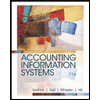
Auditing: A Risk Based-Approach to Conducting a Quality Audit
10th Edition
ISBN: 9781305080577
Author: Karla M Johnstone, Audrey A. Gramling, Larry E. Rittenberg
Publisher: South-Western College Pub
expand_more
expand_more
format_list_bulleted
Question
Chapter 3, Problem 34MCQ
To determine
Introduction: Monitoring is a procedure that gives input on the adequacy of each of the five parts of inner control. The board chooses a blend of progressing assessments, separate assessments, or a blend of the two to achieve monitoring.
To choose: The correct option.
Expert Solution & Answer
Want to see the full answer?
Check out a sample textbook solution
Students have asked these similar questions
need help by real expert and true answer.cff
General Accounting Question
Compute the amount of work in process inventory
Chapter 3 Solutions
Auditing: A Risk Based-Approach to Conducting a Quality Audit
Ch. 3 - Prob. 1TFQCh. 3 - Prob. 2TFQCh. 3 - Prob. 3TFQCh. 3 - Prob. 4TFQCh. 3 - Prob. 5TFQCh. 3 - The control environment is seen as the foundation...Ch. 3 - Prob. 7TFQCh. 3 - Prob. 8TFQCh. 3 - Prob. 9TFQCh. 3 - Prob. 10TFQ
Ch. 3 - Prob. 11TFQCh. 3 - Prob. 12TFQCh. 3 - Prob. 13TFQCh. 3 - Prob. 14TFQCh. 3 - Prob. 15TFQCh. 3 - Prob. 16TFQCh. 3 - Prob. 17TFQCh. 3 - Prob. 18TFQCh. 3 - Prob. 19TFQCh. 3 - Prob. 20TFQCh. 3 - Prob. 21MCQCh. 3 - Prob. 22MCQCh. 3 - What are the components of internal control per...Ch. 3 - Prob. 24MCQCh. 3 - Prob. 25MCQCh. 3 - Which one of the following components of internal...Ch. 3 - Prob. 27MCQCh. 3 - Prob. 28MCQCh. 3 - Prob. 29MCQCh. 3 - Prob. 30MCQCh. 3 - Prob. 31MCQCh. 3 - Prob. 32MCQCh. 3 - Prob. 33MCQCh. 3 - Prob. 34MCQCh. 3 - Prob. 35MCQCh. 3 - Prob. 36MCQCh. 3 - Prob. 37MCQCh. 3 - Prob. 38MCQCh. 3 - Prob. 39MCQCh. 3 - Prob. 40MCQCh. 3 - Prob. 41RSCQCh. 3 - Prob. 42RSCQCh. 3 - Prob. 43RSCQCh. 3 - Prob. 44RSCQCh. 3 - Distinguish between entity-wide and transaction...Ch. 3 - Refer to Exhibit 3.2. List the principles...Ch. 3 - Prob. 47RSCQCh. 3 - Prob. 48RSCQCh. 3 - Prob. 49RSCQCh. 3 - Prob. 50RSCQCh. 3 - Refer to Exhibit 3.3. For each risk assessment...Ch. 3 - Prob. 52RSCQCh. 3 - Prob. 53RSCQCh. 3 - Prob. 54RSCQCh. 3 - Prob. 55RSCQCh. 3 - Prob. 56RSCQCh. 3 - Prob. 57RSCQCh. 3 - Prob. 58RSCQCh. 3 - Authorization of transactions is a key control in...Ch. 3 - Prob. 60RSCQCh. 3 - Prob. 61RSCQCh. 3 - Prob. 62RSCQCh. 3 - Prob. 63RSCQCh. 3 - Prob. 64RSCQCh. 3 - Prob. 65RSCQCh. 3 - Prob. 66RSCQCh. 3 - Prob. 67RSCQCh. 3 - Prob. 68RSCQCh. 3 - Refer to Exhibit 3.9. What are the important...Ch. 3 - Refer to Exhibit 3.10 and Exhibit 3.11. Describe...Ch. 3 - Prob. 71RSCQCh. 3 - Prob. 72RSCQCh. 3 - Prob. 73RSCQCh. 3 - Prob. 74RSCQCh. 3 - Assume that management is gathering evidence as...Ch. 3 - Prob. 76RSCQCh. 3 - Prob. 77RSCQCh. 3 - Prob. 78RSCQCh. 3 - Prob. 79FFCh. 3 - Diamond Foods, Inc. (LO 8, 9) In February 2012,...
Knowledge Booster
Learn more about
Need a deep-dive on the concept behind this application? Look no further. Learn more about this topic, accounting and related others by exploring similar questions and additional content below.Similar questions
- Please show me the correct way to solve this financial accounting problem with accurate methods.arrow_forwardWhat is the operating cash flow?arrow_forwardAlpine Manufacturing Company's high and low level of activity last year was 62,000 units of product produced in July and 24,000 units produced in December. Machine maintenance costs were $186,500 in July and $89,300 in December. Using the high-low method, determine an estimate of total maintenance cost for a month in which production is expected to be 40,000 units.arrow_forward
- Summer Tyme, Inc., is considering a new 4-year expansion project that requires an initial fixed asset investment of $2,808 million. The fixed asset will be depreciated straight-line to zero over its 4-year tax life, after which time it will be worthless. The project is estimated to generate $2,496,000 in annual sales, with total costs of $998,400. Required: If the tax rate is 35 percent, what is the operating cash flow (OCF) for this project?arrow_forwardGiven step by step explanation for general accounting question with 100% correct solutionarrow_forwardI am trying to find the accurate solution to this general accounting problem with appropriate explanations.arrow_forward
arrow_back_ios
SEE MORE QUESTIONS
arrow_forward_ios
Recommended textbooks for you
 Auditing: A Risk Based-Approach (MindTap Course L...AccountingISBN:9781337619455Author:Karla M Johnstone, Audrey A. Gramling, Larry E. RittenbergPublisher:Cengage Learning
Auditing: A Risk Based-Approach (MindTap Course L...AccountingISBN:9781337619455Author:Karla M Johnstone, Audrey A. Gramling, Larry E. RittenbergPublisher:Cengage Learning Accounting Information SystemsFinanceISBN:9781337552127Author:Ulric J. Gelinas, Richard B. Dull, Patrick Wheeler, Mary Callahan HillPublisher:Cengage Learning
Accounting Information SystemsFinanceISBN:9781337552127Author:Ulric J. Gelinas, Richard B. Dull, Patrick Wheeler, Mary Callahan HillPublisher:Cengage Learning Accounting Information SystemsAccountingISBN:9781337619202Author:Hall, James A.Publisher:Cengage Learning,
Accounting Information SystemsAccountingISBN:9781337619202Author:Hall, James A.Publisher:Cengage Learning, Auditing: A Risk Based-Approach to Conducting a Q...AccountingISBN:9781305080577Author:Karla M Johnstone, Audrey A. Gramling, Larry E. RittenbergPublisher:South-Western College Pub
Auditing: A Risk Based-Approach to Conducting a Q...AccountingISBN:9781305080577Author:Karla M Johnstone, Audrey A. Gramling, Larry E. RittenbergPublisher:South-Western College Pub

Auditing: A Risk Based-Approach (MindTap Course L...
Accounting
ISBN:9781337619455
Author:Karla M Johnstone, Audrey A. Gramling, Larry E. Rittenberg
Publisher:Cengage Learning

Accounting Information Systems
Finance
ISBN:9781337552127
Author:Ulric J. Gelinas, Richard B. Dull, Patrick Wheeler, Mary Callahan Hill
Publisher:Cengage Learning

Accounting Information Systems
Accounting
ISBN:9781337619202
Author:Hall, James A.
Publisher:Cengage Learning,

Auditing: A Risk Based-Approach to Conducting a Q...
Accounting
ISBN:9781305080577
Author:Karla M Johnstone, Audrey A. Gramling, Larry E. Rittenberg
Publisher:South-Western College Pub
Internal Control Components; Author: Accounting Instruction, Help, & How To;https://www.youtube.com/watch?v=D8SSaqpE6L8;License: Standard Youtube License